
Denitrifying Bioreactor
Practice Overview
Tile water is diverted through an underground bed of woodchips or other carbon source. Bacteria on the woodchips converts nitrates in the water into atmospheric nitrogen gas.
Benefits
- Denitrification (35% to 50%)
- Can be retrofitted on existing systems
- Can be used in conjunction with subirrigation, controlled drainage, etc.
How It Works
When completely submerged (low-oxygen, anerobic conditions) bacteria on the woodchips will utilize the carbon (woodchips) to convert nitrates in the water into nitrogen gas. The bacteria essentially “eats” carbon, and “breaths” nitrogen. Water levels can be adjusted for field operations and bioreactor effectiveness.
Installation Considerations
- Need consistent flow
- Most efficient on 30- to 100-acres tile systems
- Typical footprint of 30’ x 100’
- Use coarse, square woodchips, ½” to 2” in size, and free of dirt and debris
- Utilize rock around manifolds for increased infiltration and pipe support
- Avoid short-circuit flow by placing control structures on either side of the trench
Costs
- Installation: $8,000 to $12,000
- Recharge: $3,000
- Cost/Benefit: $0.95/lb of N removed